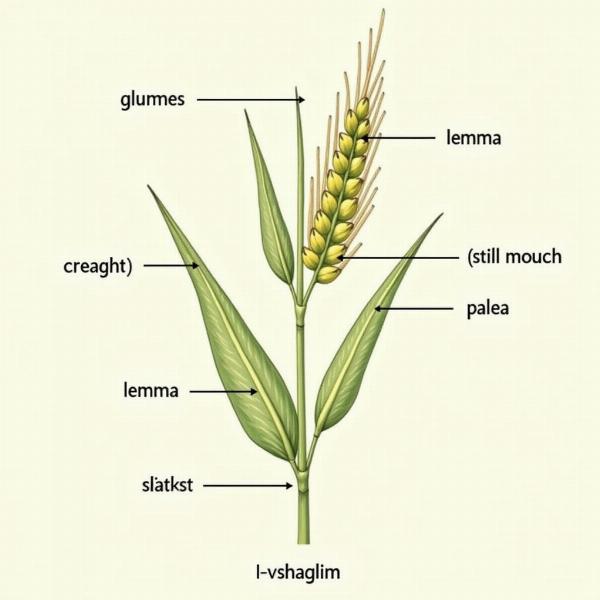Spikelet, a seemingly simple word, often sparks curiosity among those encountering it in botanical or agricultural contexts. Understanding its meaning in Hindi clarifies its significance in Indian agriculture and everyday conversations. This article delves into the various aspects of “spikelet meaning in Hindi,” exploring its definition, usage, and cultural relevance.
What Does Spikelet Mean in Hindi?
The Hindi word for spikelet is “शूकिका” (pronounced shūkikā). It refers to a small, unit of a flower cluster in grasses, including major crops like rice, wheat, and corn. Think of it as the basic building block of the larger ear or panicle. Each spikelet contains one or more florets, which eventually develop into grains. Understanding this term is crucial for anyone involved in agriculture or studying botany in India. It’s a foundational concept in understanding plant structure and crop development.
 Diagram of Spikelet Structure
Diagram of Spikelet Structure
Spikelet’s Importance in Indian Agriculture
Given India’s reliance on cereal crops, the concept of a spikelet is deeply intertwined with the nation’s agricultural practices. The size and number of spikelets directly impact crop yield. Farmers and agricultural scientists closely monitor spikelet development to assess crop health and predict harvests. Understanding the nuances of spikelet formation is key to improving crop varieties and maximizing productivity.
Spikelet in Botanical Terminology
Beyond its agricultural significance, “shūkikā” also holds importance in botanical studies. It’s a technical term used to describe the inflorescence structure of grasses. Botanists use this term to classify different grass species and understand their evolutionary relationships. The arrangement and characteristics of spikelets are crucial for plant identification and taxonomic classification.
Common Questions about Spikelets: What, Why, and How?
Do you ever wonder how a tiny spikelet contributes to the food on your plate? Understanding its role is crucial. From the farmer’s field to the consumer’s table, the journey of a spikelet is a fascinating process.
How does a spikelet develop into a grain?
The florets within a spikelet contain the reproductive parts of the grass plant. After pollination, these florets develop into grains, which are harvested and processed for consumption. The health and development of the spikelet directly influence the quality and quantity of the grain produced.
Why is spikelet size important?
The size of a spikelet is a key indicator of potential grain yield. Larger, well-developed spikelets generally result in larger grains and higher overall yields. Factors like genetics, environmental conditions, and nutrient availability influence spikelet size.
Expert Insights on Spikelets
Dr. Asha Sharma, a renowned botanist specializing in cereal crops, shares her perspective: “Spikelet development is a complex process influenced by a multitude of factors. Understanding these factors is crucial for developing strategies to enhance crop yields and ensure food security.”
Prof. Vijay Kumar, an agricultural scientist, adds, “Farmers have traditionally used visual observation of spikelets to assess crop health. Modern agricultural practices now incorporate advanced techniques to analyze spikelet characteristics and optimize crop management.”
Conclusion
Understanding the “spikelet meaning in Hindi” – “शूकिका” (shūkikā) – is not merely about knowing a botanical term. It’s about appreciating the intricate processes that sustain our food supply. From the microscopic level of plant structure to the macroscopic scale of agricultural production, the spikelet plays a vital role. This understanding empowers us to appreciate the complexity of nature and the importance of scientific advancements in agriculture.
FAQ
- What is the simplest definition of a spikelet? A spikelet is the basic flowering unit of grasses, containing one or more florets that can develop into grains.
- Why is understanding spikelets important for Indian farmers? Spikelet development directly affects crop yield and quality in major Indian crops like rice and wheat.
- How does the term “shūkikā” contribute to botanical studies? “Shūkikā” is a precise term used for classifying and identifying grass species based on their inflorescence structure.
- What factors influence spikelet development? Genetics, environmental conditions, and nutrient availability are some key factors.
- How can I learn more about spikelet development in specific crops? Consult agricultural research institutions and universities for detailed information.
- Are there any tools to measure spikelet characteristics? Yes, modern agricultural research employs various techniques to analyze spikelet size, number, and other traits.
- What is the connection between spikelet size and grain yield? Larger, healthier spikelets usually result in larger grains and higher overall yields.
Related Articles
(This section will be populated if relevant articles exist on the website)
About Meaning-Hindi.in
Meaning-Hindi.in is your trusted partner for professional Hindi translation services. We offer a comprehensive range of solutions, from business and legal document translation to technical, website, educational, and specialized translations. Our expert team ensures accurate, culturally sensitive, and high-quality translations to meet your specific needs. Whether you need business document translation or technical manual translation, our expertise in various domains ensures accurate and nuanced results. For a free quote, contact us at [email protected] or call us at +91 11-4502-7584. Let Meaning-Hindi.in bridge the language gap for you!